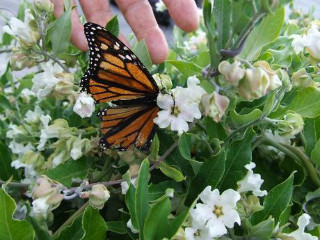New Zealand struggling with butterfly-killing plant causing monarch butterflies' death
Community and Forum → Blog → New Zealand struggling with butterfly-killing plant causing monarch butterflies' death
Lev Bely, 15.02.2013 20:32
Climber Araujia sericifera belonging to the Apocynaceae family has different common names including “moth plant” and “cruel vine”. Its beautiful white flowers have plenty of sweet, sticky nectar, which attracts monarch butterflies (Danaus plexippus). The latter get deadly stuck to flowers trying to feed on and eventually die right on-site.
New Zealand's leading the serious campaign against the moth plant, which moreover has a bad reputation of an invasive toxic plant. The climber has been added to the National Pest Plant Accord and to the Ministry for Primary Industry list of unwanted plants that cannot be sold, propagated or distributed.
The Auckland Council recommends people pull out all the moth plant seedlings and bury them deeply, as well as using stump paint and herbicides.
The Northland Regional Council biosecurity officer Sara Brill said the plant was ranked among the top non-pastoral climbing pest plants.
“It invades and smothers native forest areas, garden shrubs, shelterbelt trees and roadside plants, and its milky, sticky sap can also cause skin irritation and ill health.”
It was also a killer of monarch butterflies, she said.
“The moth plant, or perhaps more aptly named “cruel plant” as it is sometimes known, has masses of lovely flowers full of nectar at the moment. Unfortunately, what the unsuspecting butterfly doesn't know is that this nectar is so sticky it will trap the butterfly's tongue and it can't get away.”
Ironically, monarch larvae known to develop solely on milkweed can be alternatively fed on this very Araujia sericifera plant if offered instead of milkweed.
As it happens, such “flower detainee” eventually dies not being able to unstick itself. Recently in Whangarei Brill and a colleague spotted a rather small Araujia with a bunch of dead monarchs stuck to its flowers.
The plant can be easily recognised by its climbing vine, elongated paired leaves and particularly small, clustered white flowers, which develop into oblong seed pods.
People keen to get rid of moth plants could remove small infestations by hand, Ms Brill said.
“Seedlings are easy to pull but even large plants can be easily killed by finding the main root and pulling out about 5cm of the root. The plant will wilt within 24 hours and you can see if you have missed any smaller ones.”
Large infestations might need to be over-sprayed using specialised herbicide, Ms Brill said.
The New Zealand Herald, http://www.nzherald.co.nz
Photo: dead monarch butterfly in the Araujia sericifera flower, http://www.nzherald.co.nz
All the rest posts on: Pests, garden things, New Zealand, danger zone, agriculture, technology, ecology
Comments
New comment
Note: you should have a Insecta.pro account to upload new topics and comments. Please, create an account or log in to add comments.
* Our website is multilingual. Some comments have been translated from other languages.
Random species of the website catalog
News
- 02.03.2025: Moscow Insect Fair: New section on the Insecta.pro Website
- 31.12.2024: If you need to upload a lot of photos to Insecta.pro website
- 10.12.2024: Новое поле в «Поиске энтомологов»
New photos (25.03.2025)
Fresh from the community
- 12:52, L. Bolshakov: Петр, см. там подробности: https://...
- 12:32, P. Khramov: Лавр, источник скиньте, пожалуйста....
- 23:33, L. Bolshakov: К сожалению, вы поступили неверно. ...
Popular insects
Recommended blog topics
- ICZN Election of Commissioners
- Interview with Alexander Zatakovoy, one of the wild Russian entomologists
- Meanwhile, at the "Reptilium"
- Awesome critter: the Oleander moth




























